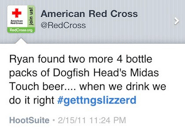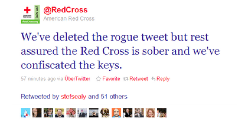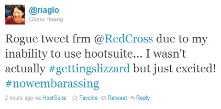![]()
If you’ve ever blogged, tweeted, updated your status on Facebook – or even sent an e-mail – you know what it’s like to have “click regret.” Click regret is when you write something – be it 140 characters, or a pithy e-mail response – click send, update or publish, only to realize that what you wrote was not what you meant at all. Or worse yet, you just broadcasted particularly personal – or even embarrassing – information to a huge or unintended audience.
That’s exactly what happened to Gloria Huang, a social media specialist at the national headquarters of the American Red Cross in Washington, D.C. “I was shocked and horrified,” Huang said of her recent click regret moment involving the popular social media website, Twitter. “Your first instinct is to run and hide, but you can’t. It’s public. It’s out there.”
Huang spent a Tuesday evening this February like many of her age and profession do – she checked in on her social media accounts – Facebook, Twitter, and others. Just before going to sleep that night, Huang sent the following tweet:

There was nothing particularly outrageous about the tweet, except that instead of sending the tweet from her personal account (@riaglo), Huang mistakenly used her employer’s Twitter account (@RedCross) to send what has since become known in the Twitterverse as, the “rogue beer tweet.” Huang went to sleep that night blissfully unaware of the mix up.

Wendy Harman, director of social media for the American Red Cross, might not have slept as well as Huang that night. She began receiving calls soon after the errant tweet went live. But to her credit, Harman didn’t panic. Instead she responded with one of the more elegant and humorous tweets one might read on Twitter.
Huang also used her personal Twitter account to assuage any damage done by the errant tweet:

Huang and Harman’s approach was successful. According to Huang the organization saw a slight bump in donations in the days that followed the incident. The Dogfish Head beer company used their blog and Twitter account to spark a buzz and send would-be donors to the Red Cross. And HootSuite, the social media tool that Huang used to send her tweet, got in on the act – the company sent beverage cozies to both Dogfish and Huang, and donated $100 to the Red Cross.
It’s always nice when a story has a happy ending. Red Cross may have set the gold standard for social media click regret damage control. For a group used to jumping into real disaster zones, the incident was comparably small potatoes. And yet the issue raises real concerns for nonprofits everywhere that have become increasingly dependent on social media to create relationships, promote advocacy, spread mission, and even fundraise.
And while the Red Cross’ social media mishap was relatively benign, other, more serious Twitter foibles show how potentially powerful the medium can be. An Indiana deputy district attorney recently was fired for advocating on his personal Twitter account the use of “live ammunition” on the protesters in Wisconsin who were demonstrating against Gov. Scott Walker’s plan to curtail collective bargaining rights.
The Indiana case shows how the line between personal and organizational social media has become fuzzier in recent years. So much so, that most policies and approaches dealing with social media encompass a user’s overall social media presence. Whether tweeting from a personal account or keeping a personal blog, or engaging in social media through organizational accounts, employees should realize that they are speaking for the organization they work for – for good or bad. Despite best attempts to keep anonymous on the web, it is becoming harder and harder to do so. “When you work for us, you are an ambassador for the Red Cross, whether you like it or not and whether we like it or not,” said Harman of the Red Cross. Harman added that she is thrilled with the social engagement of her far flung staff.
There have been scores of other firings and legal sanctions in the recent past too (not all in the public or nonprofit spheres): Chad Ochocinco of the NFL’s Cincinnati Bangels was fined for breaking the league’s rules about social media, journalist, Octavia Nasr, formally of CNN was fired for tweeting what appeared to be pro Hezbollah comments, Mike Bacsik, former producer at KTCK-AM in San Antonio, Texas was fired for a racist tweet, and ex-rocker Courtney Love was sued in the first known case of Twitter libel in 2009.
Risks like these – breaking confidentiality agreements, releasing unauthorized photographs, and otherwise creating hostile environments (sexual harassment, discrimination) or breaking other laws – are all possible outcomes in a world where social media is king.
SUBSCRIBE | Click Here to subscribe to THE NONPROFIT QUARTERLY for just $49
Nonprofits can and do lawfully discharge employees for such offenses. In fact, federal and state laws require employers to take action to prevent or eliminate harassment both in the workplace and on social media sites. As with all types of workplace behavior, an employer may be liable for the employee’s behavior, according to the website SocialWorkplace.com.
In this social media landscape, according to experts and those in the trenches, you’d better have a plan – both to limit embarrassing social media mishaps and to guard against the less likely but potentially more damaging offenses.
Emily Culbertson, a web and social media strategist based in Chicago who works with nonprofits and foundations said that social media policies are essential. Organizations should have a policy that articulates “common expectations” around the use of social media. “A social media policy should not say ‘Here’s what you can and can’t do online. But here are ways to relate and learn online that don’t cross that bright line,” she said
Culbertson is not alone in her views. The conversation has shifted over the last few years from whether or not to have a policy, to how best to create a living set of guidelines and principles that guide and inspire employees based on organizational values.
Sign up for our free newsletters
Subscribe to NPQ's newsletters to have our top stories delivered directly to your inbox.
By signing up, you agree to our privacy policy and terms of use, and to receive messages from NPQ and our partners.
Beth Kanter, co-author of “The Networked Nonprofit” says, “A social media policy should be one that supports and strengthens the organization’s social media strategy, not a set of commandments that start with ‘Thou shall not do X.’ It should be encouraging, but also provide guidance.”
Holly Ross, executive director of the Nonprofit Technology Network (NTEN), based in Portland, Ore., says there is no way to completely avoid the errant tweet or the unfortunate Facebook update, but in anticipation of such incidents every organization should have a social media policy. Ross, who admitted to mistakenly tweeting about needing a haircut using NTEN’s Twitter account instead of her own, says social media policies should be “married to the organization’s culture and mission. It should reflect who the organization is.”
It’s clear that the American Red Cross is comfortable with its social media presence – even when the unexpected happened. Huang said that their approach at the Red Cross has been to create a set of guidelines, not necessarily rules. “It’s important not to restrict people – but to let them find their own voices.”
The Red Cross helps their 35,000 employees from nearly 700 locally supported chapters find their voice by continuing education about the attitudes and culture surrounding social media. “We try very hard to empower our people to have their own personalities on social media,” Huang says. Not every Red Cross employee uses social media, but the challenge of embracing the tools – and their inherent lack of control – requires that the organization present a confident voice to its employees.
Red Cross CEO Gail McGovern did just that. Soon after the rogue beer tweet, McGovern sent Huang a personal e-mail to make sure she was doing all right and felt good about the organization’s response. McGovern realized that the trade off of having an engaged and responsive staff, tuned into social media, might entail the occasional hiccup.
Social media policies aren’t just a challenge for established giants like the Red Cross, but younger, smaller nonprofits also grapple with these issues. Being cheap, loud, and fast, social media can be a boon for smaller groups with smaller budgets. At the Public Conversations Project in Watertown, Mass., the communications and social media team rely on a social media strategy, instead of a codified set of policies. “Social media should be integrated into an organization’s overall strategy, mission, and values, so you already have standards built in,” said Susan Countryman, director of communications and development at the Public Conversations Project.
The Public Conversations Project’s goal is to bring deeply divided groups together in dialogue and facilitate a mediation process between polarized groups.
With 12 full-time staff, the group feels it is nimble enough for social media to remain an organic extension of their core values. “We’re small enough that we can remain collaborative,” said Roger Baumann, the Conversations Project’s social media coordinator. Countryman added, “The gist of what we do as an organization is thoughtful communication, so at this point it’s less of a concern for us.”
Both Countryman and Bauman agree that the most important aspect of their social media plan is that it humanizes the organization. “Relationship building is the core of development and communications,” said Countryman, and there’s no better way to do that than by using social media effectively.
For Mobilize.org, a “Millennial led” nonprofit based in Washington, D.C., the use of social media is a natural fit for the group. Not only has everyone at the organization grown up with some form of social media at their fingertips most of their lives, but with only seven full-time staff and no advertising budget, tools like Facebook and Twitter are the best way to engage their audience. “We understood that this is the primary way our generation is communicating,” said Ayofemi Kirby, director of communications. “It’s a business imperative for us to get out there and be part of the conversation.”
But even this group, run by and for Millennials, has felt the need for a social media policy. “We make it clear to every staff member and every intern that there are certain expectations around social media that they have to follow,” Kirby said. It’s nice to use the free social media tools, “but we want to use a unified, organizational voice.”
Like most people interviewed for this piece, Kirby stresses that a social media policy should not be restrictive. In fact, the group mandates that every staff member and intern be active on at least one personal social media platform. “We don’t try to limit or control the use of social media,” she said. “There is always resentment if you try to control.”
FREE DELIVERY | Click Here to sign up for THE NONPROFIT NEWSWIRE, Delivered Daily >>
The fear and distrust that used to cloud upper management’s discussions of social media policy have given way to a more nuanced and collaborative approach that embraces the sometimes out of control – but always engaging and responsive – nature of the tools.
Kanter, who was named by Fast Company Magazine as one of the most influential women in technology in 2009 said, “Social media policy needs to be a living document. It isn’t a bunch of biolerplate written by lawyer that sits in a drawer. Training and education must accompany the policy – and of course there must be a culture of learning, not blame. I think the recent example of how the Red Cross handled their social media mistake is something that we should all strive for.”
The Red Cross rogue beer tweet may act as a pivotal moment in the ever-changing social media landscape.The Red Cross response acknowledged that we are all human and that we all make mistakes. In fact becoming more human is a goal all organizations should strive for.
But what about those fireable offenses? What happens when an employee crosses that bright line? For their part, the Red Cross has developed two distinct documents. One encourages and guides employees on how best to manage social media accounts. The other document lays out clearly what is not acceptable behavior on social media.
But the Red Cross has taken a light handed approach, says Harmon. The document reads in part, “Your communications should be transparent, ethical and accurate.” Then the document refers employees to other policies that are already in place that govern these types of behaviors found in the fundamental principles and core values of the organization as well as the organizations official code of conduct.
The most powerful thing about social media is that it allows more and more people to directly participate in “the conversation.” Conversely, the most dangerous thing about social media is that it allows more and more people to directly participate in “the conversation.” But there’s no putting this genie back in the bottle. After all, a tweet, blog post, Facebook update, or video can’t very well “go viral” if you haven’t lost some control of the message.
Huang, the now infamous beer tweeter said of her experience, “Your little corner of the Internet can quickly spread to be all over the Internet.” Once we are all comfortable with – and embrace – that assumption, the better and more effective we will all become at using these tools.
We’d like to know what you think. Has finding your social media voice been difficult? How did you go about formulating social media guidelines or policies? Were there missteps along the way?
For more information about all things social media read Beth Kanter’s Blog, and visit socialmediagovernance.com for access to dozens of social media policies.













